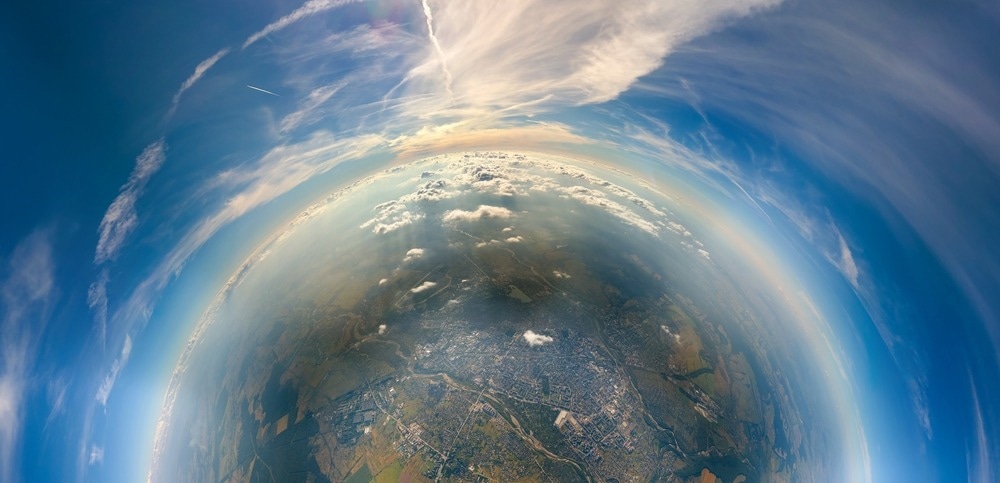A recent review paper published in the Journal of Remote Sensing comprehensively explored the progress and challenges of using satellite remote sensing technology to monitor tropospheric ozone, a key gas affecting climate change and air pollution. The researchers provided a detailed overview of advancements in satellite sensors and retrieval algorithms and discussed the current limitations and future directions in this field.

Image Credit: Bilanol/Shutterstock.com
Background
Tropospheric ozone is an important component of the Earth's atmosphere, and its accurate monitoring is crucial for managing climate change and air pollution. This ozone forms in the lower atmosphere through the interaction of ultraviolet (UV) radiation with nitrogen oxides and volatile organic compounds. It significantly impacts the Earth's climate, with variations closely linked to human activities like fossil fuel combustion and industrial processes. Therefore, accurate monitoring is essential for understanding and addressing these effects. Satellite remote sensing is a powerful tool for tracking tropospheric ozone globally and regionally, providing valuable data to analyze its patterns and sources.
About the Review
The paper focused on advancements in satellite remote sensing of tropospheric ozone, providing a comprehensive review of the evolution of satellite sensors and retrieval algorithms. It included passive and active remote sensing methods, highlighting their strengths and weaknesses. The study began by reviewing the historical development of satellite instruments for ozone monitoring, including contributions from major space agencies like NASA and ESA. It then discussed different types of satellite sensors, such as ultraviolet (UV), thermal infrared (TIR), and light detection and ranging (LIDAR), examining their advantages and limitations for measuring ozone.
The authors also analyzed various categories of retrieval algorithms used to derive tropospheric ozone data from satellite measurements, including direct, indirect, and innovative methods. They compared these algorithms in terms of accuracy, efficiency, and suitability for different scenarios, helping to understand the trade-offs and practical applications. The importance of using prior information, such as atmospheric profiles and surface reflectance, to improve the accuracy of retrieval algorithms was also discussed.
Key Findings
The outcomes showed that while significant progress has been made in satellite remote sensing of total ozone, accurately retrieving tropospheric ozone remains challenging. Factors like weak signals from the lower atmosphere, clouds, aerosol interference, the Earth's complex surface, and limited spatial and temporal resolution of satellite measurements pose difficulties. The study also highlighted the limitations of current satellite tropospheric ozone datasets, which often contain significant errors, hindering the analysis of long-term trends and identifying influencing factors.
Despite these challenges, the researchers highlighted several promising developments in satellite technology and retrieval algorithms. New-generation UV/VIS hyperspectral sensors, such as the tropospheric monitoring instrument (TROPOMI), ozone mapping and profiler suite (OMPS), and ozone monitoring suite (OMS), offer enhanced capabilities for precise spatiotemporal analysis of ozone trends. Additionally, combining nadir and limb viewing modes in sensors like OMS and OMPS further improves detection capabilities.
Additionally, the authors discussed innovative algorithms, such as integrating multi-band ozone data, combining nadir-limb ozone observations, and using machine learning-based retrieval methods. These advancements are crucial for overcoming the limitations of traditional algorithms and achieving more accurate and efficient tropospheric ozone retrieval.
Furthermore, the study demonstrated the potential of using satellite data to analyze the impact of human activities on tropospheric ozone levels. It showed how satellite data could be used to investigate the relationship between tropospheric ozone and emissions from fossil fuel combustion and industrial processes, identify areas with high emissions levels, and monitor the effectiveness of emission reduction strategies.
Applications
Accurately retrieving tropospheric ozone from satellite data has significant implications for climate change research, air quality monitoring, public health, and policy development. The research emphasized the importance of using satellite data for environmental monitoring and policy, highlighting the need for ongoing research and development. It also demonstrated the potential of satellite data to support decision-making in energy, transportation, and agriculture sectors. This integrated approach can provide a more comprehensive understanding of tropospheric ozone dynamics and support the development of effective emission reduction strategies.
Conclusion
In summary, the study reviewed advancements in satellite remote sensing of tropospheric ozone, highlighting the challenges and opportunities in this field. The authors emphasized the need for continued research in satellite technology and retrieval algorithms to improve the accuracy and reliability of tropospheric ozone measurements.
Future work should focus on enhancing instrument calibration, increasing the signal-to-noise ratio, optimizing spatial and temporal resolution, and using hyperspectral sensor technology. Accurate and reliable retrieval of tropospheric ozone is crucial for understanding and mitigating climate change and air pollution, and further advancements will significantly influence environmental monitoring and policy. International collaboration and data sharing would also help advance the field of satellite remote sensing of tropospheric ozone.
Disclaimer: The views expressed here are those of the author expressed in their private capacity and do not necessarily represent the views of AZoM.com Limited T/A AZoNetwork the owner and operator of this website. This disclaimer forms part of the Terms and conditions of use of this website.
Source:
Xu, J., & et, al. Remote Sensing of Tropospheric Ozone from Space: Progress and Challenges. Journal of Remote Sensing, 4, 0178, 2024. DOI: 10.34133/remotesensing.0178. https://spj.science.org/doi/10.34133/remotesensing.0178